Summary
Receding inflation doesn’t mean the battle is won yet
We remain sceptical on inflated valuations because the uptrend in risk assets is due to the laggards catching up rather than any meaningful improvement to earnings outlooks.
The optimism on risk assets behaviour partly stems from most of the hiking cycle now being behind us and a better-than-previously-expected economic picture, mainly in the US. Here, we continue to expect a mild recession in 4Q23/1Q24, but we upgraded our 2023 growth forecast to 1.6% on the back of better Q1 growth revisions. The Eurozone should avoid a recession, but risks related to ECB overtightening and growth divergences among countries persist. For China, we downgraded 2023 growth forecasts to 5.1% due to a weak Q2 and delayed stimulus. Consequently, the following factors could drive economic considerations:
- Excessive optimism on shaky foundations. The strength in US growth is more mechanical and forward-looking indicators point to subdued activity. In Europe, risks are skewed to the downside, also because of the weakness in China.
- Watch out for core inflation regarding the policy path. Core disinflationary trends (and not a mild recession) could prompt the Fed to cut rates next year. But core inflation could still be sticky. Another factor to watch is real funds rates.
- Upward pressures on terminal rates. The ECB is not in a pause mode. Even for the Fed, we see pressures on our terminal rates forecast of 5.5%. However, financial stability concerns and financial conditions amid risks of overtightening must be monitored.
- Long-term shift from West to East remains. Despite China moving to lower growth, EM continue to present selective opportunities.
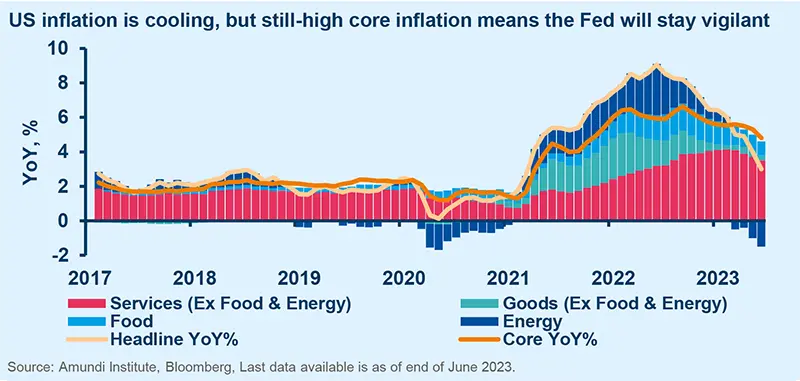
We see opportunities in the following areas:
- Cross asset, enhance diversification. We are now slightly positive on Europe duration and remain constructive on the US, but we now see a case for some protection here on an uncertain inflation path. We are cautious on credit, particularly HY, and on DM equities. In EM equities, we do not change our positive stance, but adjust it by replacing the positive view on China with broader EM. We continue to like EM bonds, and are now marginally constructive on Czech government bonds, but believe currency risks should be hedged. Overall, we believe investors should seek protection on equities and keep a small positive view on gold for diversification.
- Bonds remain in focus. Volatile fixed income markets mean our stance on duration and corporate credit stays very active. On the former, we remain marginally positive on the US, but are flexible. In core Europe, we are moving close to neutral and are monitoring the evolution of economic data, but we stay defensive on Japan. In credit, our preference continues to be for high-quality IG, while in HY, we stay cautious and believe there is a need to differentiate between BB- and B-rated vs CCC-rated issuers. Thus, the need for selection is high, as we expect to see increases in idiosyncratic risks.
- Equities still defensive in DM. In the US, the divergences between large caps and the rest of the market remain. Regarding value, quality and defensives, we remain positive and selective. In Europe, we are assessing the decline in economic momentum, along with the impact of ECB actions and the direction of inflation. Less support from the region’s economic growth and from weakness in China could have implications for equities. As a result, our focus continues to be on quality, value and dividend-oriented stocks that reward shareholders.
- With a strong focus on selection, we are positive on EM despite some near-term weakness in China. The long-term Chinese growth story is still intact, but at a lower level and characterised by the government’s focus on better quality of life. Importantly, the EM story goes beyond China, to countries such as India and Brazil, where we are more positive on equities. In FI, we remain optimistic on HC and LC debt and on LatAm amid easing inflation.
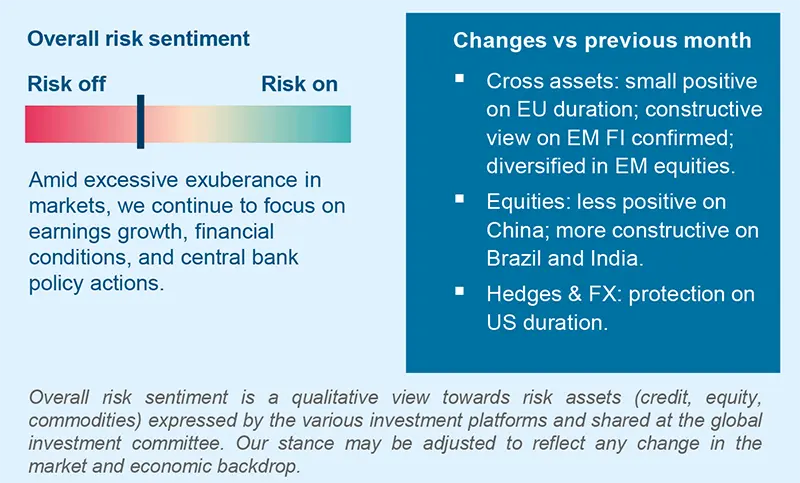
Three hot questions
|
Monica DEFEND |
We think the main DM CBs are not done with policy tightening yet, but select CBs in emerging markets are now close to cutting their policy rates, beginning with LatAm.
1| What is the main trend you see in the global monetary policy cycle?
We are seeing a desynchronisation in the global policy cycle between DM and EM. Major DM central banks could hike rates further, while some EM CBs are close to cutting rates, starting with LatAm, which has been enjoying moderating inflation over the past several months. This is the result of a timely and aggressive monetary policy response. We foresee Chile and Brazil’s CBs cutting first, followed by Colombia and Peru in September. CEE countries should follow, led by Poland, where single-digit inflation should be hit in August/September.
Investment consequences
- Easing monetary policy and stable inflation should support EM local currency bonds, with the largest upside expected in LatAm.
2| What are your expectations on the Q2 reporting season?
Second-quarter 2023 should be the first to feature negative year-on-year growth this year, both in the US and in Europe. The downswing is expected to be stronger for Europe (-8.2% from +11.1%) than for the US (-6.4% from +0.1% in Q1), with huge divergences across sectors. In the US, energy and materials are likely to report the strongest declines, with heavy influences on the aggregate result.
Investment consequences
-
Regionally, we favour Japan over the US, as the latter is very expensive.
-
From a style perspective, we favour quality in the US and Europe and value in Japan.
3| Can you offer any update on financial conditions?
Since late March, we have been experiencing a broad-based easing of US financial conditions, but they remain tight by historical standards. Today, they are more restrictive than most recent stress windows except for the GFC and the Covid-19 crisis. Unlike in the past, today, monetary policy appears the only relevant driver of financial conditions.
Investment consequences
-
Amid our overall defensive allocation, we stay cautious on equities and credit, especially on the lower-quality parts of the market.
-
We are positive on select government bonds, such as the US.
Stay diversified, without increasing risks
|
Francesco SANDRINI |
John O'TOOLE |
Investors should consider adding some protection to US duration (still high core inflation) and exploring opportunities in EM, both in fixed income and equities.
We are assessing the economic and corporate profits outlook, and valuations. But on all of these, we are not very positive, because we are seeing multiples expansion with rising rates. On the other hand, risks of a profit recession remain. This underpins our cautious view. Investors should stick to their long-term convictions but remain flexible to benefit from the EM advantage by keeping a diversified stance. At the same time, there is scope for maintaining hedges on risk assets and protection on duration, all the while adjusting FX views.
High conviction ideas
We are defensive on DM equities, including the US, Europe and Japan, but do not miss out on opportunities elsewhere. For a long time, we have maintained that the EM story goes beyond China. Thus, the recent weakness in the country’s housing and manufacturing sectors led us to move to neutral on China. Instead, we think investors should diversify into the broader EM universe, where we are now positive.
We keep a positive stance on US duration but see persistent (core) inflation as a risk, underscoring the need now for some protection. We are also now slightly constructive on EU duration after the recent upward movement in yields and indications of some economic weakness in Europe. Swedish bonds should benefit from a vulnerable domestic economy, while Italian BTP-Bunds spreads could gain from positive demand for Italian bonds and their limited supply outlook.
On JGBs, however, we are cautious but mindful of the rhetoric coming from the Bank of Japan and are monitoring policy actions. We remain active across curves, with opportunities in UK 10Y vs Australia 10Y (relatively dovish BoE) and in Canadian curve steepening. At the other end, we are positive on EM FI and now like Czech government bonds (hedged) due to their attractive carry and the country’s gradual disinflation.
We stay defensive on US HY. Current valuations look too optimistic and are inconsistent with our views of a decelerating economy and tight financial conditions. Liquidity could be another issue in this segment going forward.
In FX, we think the NOK/CAD has performed well after the recent price action and now we are no longer positive. We are pessimistic on the GBP and express this view through the EUR, CHF and JPY. We remain negative on the USD vs the EUR and vs the AUD. In EM, we like the INR/CNH, MEX/EUR and the BRL/USD.
Risks and hedging
In times of an uncertain economic growth outlook but high asset valuations, strong hedges should help adapt to the evolving backdrop. Thus, there is a persistent need to keep hedges on US equities. At the same time, precious metals e.g. gold continue to offer diversification and safety, particularly if geopolitical tensions were to rise.
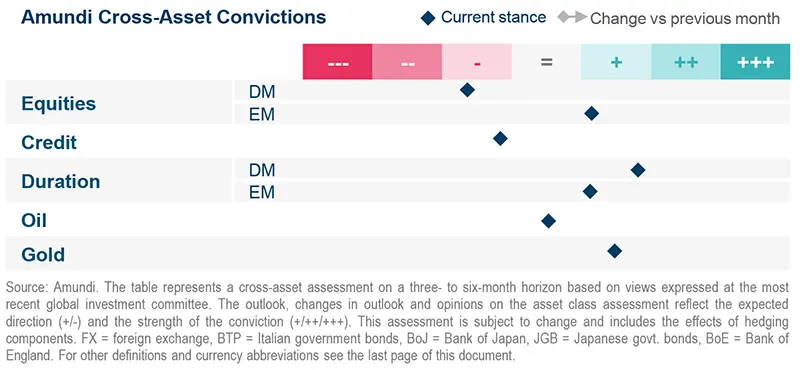
Credit quality should be a top priority
| Amaury D'ORSAY Head of Fixed Income |
Yerlan SYZDYKOV Global Head of Emerging Markets |
Kenneth J. TAUBES CIO of US Investment Management |
In times of slow growth and high valuations, we focus on quality and distinguish on basis of liquidity buffers, cash flow strength, and balance sheet leverage.
Overall assessment
The biggest concerns at this stage are the economic and inflation outlooks and the resultant impacts on earnings and valuations. Businesses with low leverage and high capital buffers should be better able to withstand this phase. We maintain our preference for quality in the US, Europe and EM.
Global and European fixed income
We are close to neutral on duration in core Europe and US, but defensive on Japan. However, we are marginally positive on duration in peripheral countries, such as Italy, and on semi-core Europe. At the same time, we see opportunities across geographies – eg, in Canadian and UK duration. Elsewhere, in credit, we think markets are pricing in a Goldilocks scenario but we remain biased towards quality in IG and subordinated financials. In HY, we prefer to distinguish between CCC-rated debt and the BB/B categories. The default rates in the former have been much higher than in B-rated debt. Secondly, we maintain our constructive view on EU financials owing to their recovery potential and strong asset quality. In contrast, low-rated non-financials could be impacted more by tighter financial conditions and higher costs of funding.
US fixed income
Markets seem to be pricing in a no (economic) landing scenario for the economy and higher-for-longer rates by the Fed. We do not agree on the first and see risks of a mild recession. This creates a difficult backdrop for duration management. We stay constructive, but manage this exposure tactically and see value in both nominal and real rates on the intermediate part of the curve. In corporate credit, we prefer IG over HY. In the latter, fundamentals are diverging between BB-/B-rated debt vs CCC issuers, with the leverage situation deteriorating for CCC in recent quarters. Thus, we prefer high-quality issuers in general. From a sector perspective, we like financials over non-financials in IG. In securitised credit, the recent spread tightening offers opportunities to benefit from the upside movement in ABS and RMBS with longer maturities and higher price volatility.
EM bonds
EM debt offers attractive entry from a historical perspective and we maintain a neutral to positive view on duration, even though we turned cautious on China. On HC, we are slightly positive, with a preference for HY over IG. We are also constructive on LC but are selective. Regionally, we like LatAm (Brazil, Mexico, Colombia), where inflation is easing, but we will monitor how Russia’s withdrawal from the grain deal could affect that. In Asia, we like countries such as Indonesia.
FX
Dollar weakness is likely to persist this year. But our positive views are centred on the JPY, AUD in DM and the INR and IDR in the emerging world. On the GBP, as soon as the market focus shifts to economic growth, the pound could suffer.
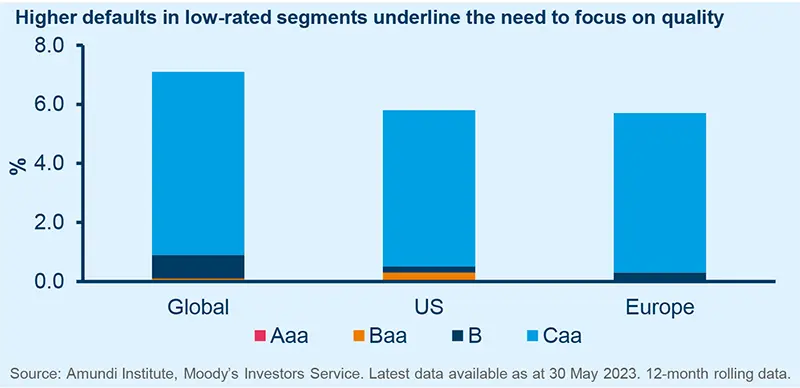
Stick to fundamentals and valuations
| Fabio DI GIANSANTE Head of Large Cap Equity |
Yerlan SYZDYKOV Global Head of Emerging Markets |
Kenneth J. TAUBES CIO of US Investment Management |
The current environment of high valuations provides an attractive backdrop for stock selection, focusing on pricing power and earnings strength.
Overall assessment
While the US recession scenario has been pushed back, markets are pricing in a too optimistic scenario without any damage to the economy. Our concerns could soon be manifested in corporate earnings, where management guidance would provide more clarity. We continue to avoid segments where valuations and earnings potential do not match. Instead, we prefer robust business models across sectors and regions, including EM.
European equities
We believe investors should maintain diversified portfolios by combining quality cyclical businesses and defensive stocks. In particular, we are attracted to those that can return cash to shareholders. Within the consumer staples sector, we like the long duration, defensive companies as well as those with some cyclical characteristics. We also favour healthcare and select pharma companies, as, similar to many staples businesses, they offer the prospect of capital appreciation and dividends. Among the cyclical sectors, industrials that encourage factory automation, sustainable transport and electrification offer good value. Elsewhere, we are constructive on retail banks, owing to their dividend yields and the positive impact of high interest rates on their margins. Finally, we are cautious on tech, particularly semiconductor stocks, due to their uncertain growth outlook.
US equities
We are cautious due to the overvaluation of the broader markets. But if we consider the value side, valuations there are fair. Value investing could apply to large cap growth as well large cap value. This means favouring the cheapest stocks in these styles if the business models are robust and earnings growth stable. At the other end, defensives (and even cyclicals) are expensive, but those that are cheap may not be worth owning. So, we differentiate by names that have a history of rewarding shareholders and go beyond traditional defensives (healthcare equipment). In cyclicals, consumer and industrial appear to be most at risk. Consumer discretionary sector could be affected by wage pressures, as valuations are already expensive. On the other hand, we prefer energy, materials, banks and non-spread financials. Finally, we think if liquidity dries up in the market, segments that are most inflated (i.e. megacaps) in terms of valuations could be most affected.
EM equities
Expectations of earnings recovery in H2 this year should be positive for EM. However, geopolitical and idiosyncratic risks could harm sentiment. Our most preferred markets are Brazil and India. In the former, valuations are attractive and we expect the CB to cut rates. India should benefit from changes to global supply chains and domestic policies. We have raised our views on both but downgraded China. At a sector level, we favour real estate and discretionary, while we keep more defensive stances on healthcare and materials.
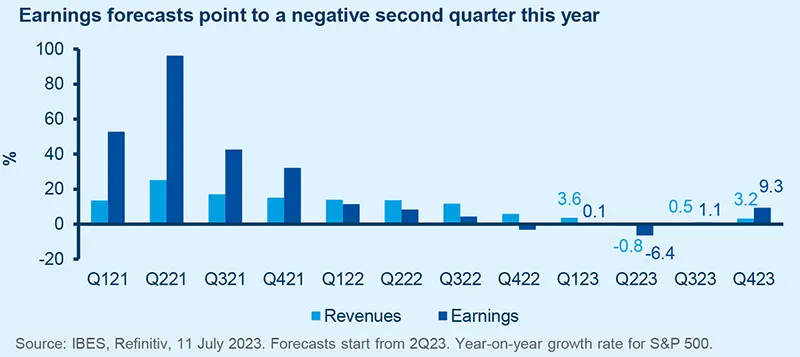
Amundi asset class views
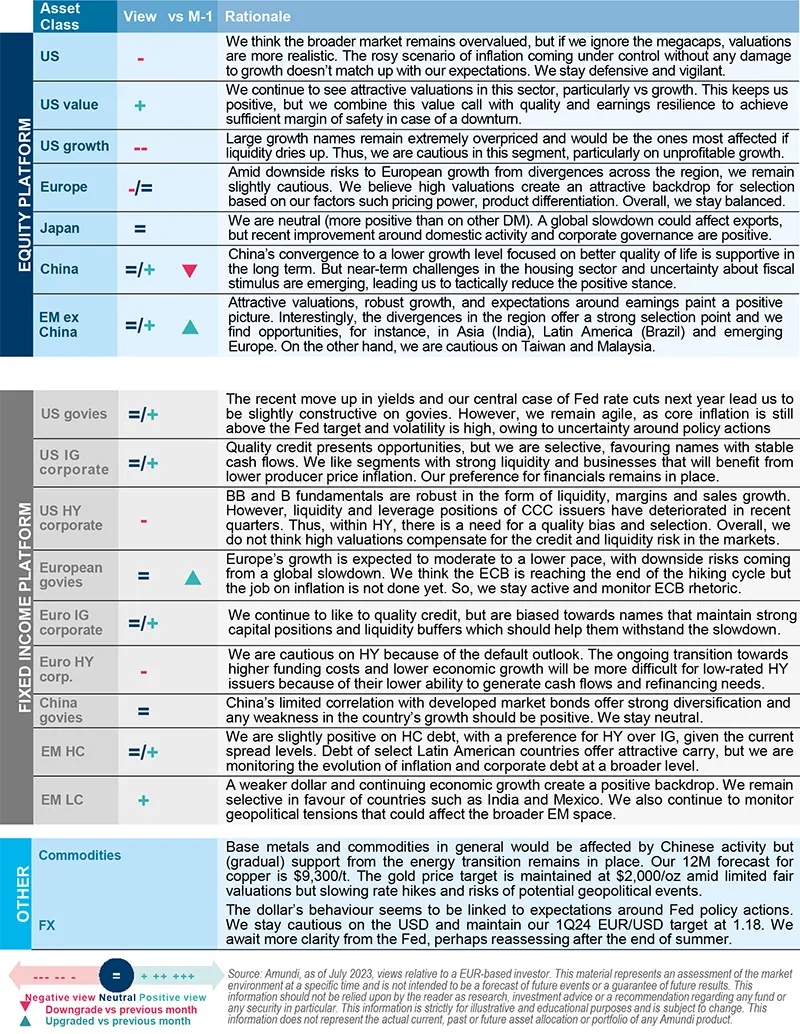
Definitions & Abbreviations
- ADR: A security that represents shares of non-US companies that are held by a US depositary bank outside the US. They allow US investors to invest in non-US companies and give non-US companies access to US financial markets.
- Agency mortgage-backed security: Agency MBS are created by one of three agencies: Government National Mortgage Association, Federal National Mortgage and Federal Home Loan Mortgage Corp. Securities issued by any of these three agencies are referred to as agency MBS.
- Beta: Beta is a risk measure related to market volatility, with 1 being equal to market volatility and less than 1 being less volatile than the market.
- Breakeven inflation: The difference between the nominal yield on a fixed-rate investment and the real yield on an inflation-linked investment of similar maturity and credit quality.
- Bull steepening: A change in the curve due to short-term rates falling faster than the long-term rates. This leads to a higher spread between the short and long term rates.
- Carry: Carry is the return of holding a bond to maturity by earning yield versus holding cash. Core + is synonymous with ‘growth and income’ in the stock market and is associated with a low-to-moderate risk profile. Core strategy is synonymous with ‘income’ in the stock market.
- CBs: Central Banks.
- Correlation: The degree of association between two or more variables; in finance, it is the degree to which assets or asset class prices have moved in relation to each other. Correlation is expressed by a correlation coefficient that ranges from -1 (always move in opposite direction) through 0 (absolutely independent) to 1 (always move in the same direction).
- Credit spread: The differential between the yield on a credit bond and the Treasury yield. The option-adjusted spread is a measure of the spread adjusted to take into consideration the possible embedded options.
- Currency abbreviations: USD – US dollar, BRL – Brazilian real, JPY – Japanese yen, GBP – British pound sterling, EUR – Euro, CAD – Canadian dollar, SEK – Swedish krona, NOK – Norwegian krone, CHF – Swiss Franc, NZD – New Zealand dollar, AUD – Australian dollar, CNY – Chinese Renminbi, CLP – Chilean Peso, MXN – Mexican Peso, IDR – Indonesian Rupiah, RUB – Russian Ruble, ZAR – South African Rand, TRY – Turkish lira, KRW – South Korean Won, THB – Thai Baht, HUF – Hungarian Forint.
- Curve steepening: A steepening yield curve may be a result of long-term interest rates rising more than short-term interest rates or short-term rates dropping more than long-term rates. Bull steepening a change in the curve due to short-term rates falling faster than the long-term rates. This leads to a higher spread between the short and long term rates.
- Curve inversion: When long-term interest rates drop below short-term rates, indicating that investors are moving money away from short-term bonds.
- Cyclical vs. defensive sectors: Cyclical companies are companies whose profit and stock prices are highly correlated with economic fluctuations. Defensive stocks, on the contrary, are less correlated to economic cycles. MSCI GICS cyclical sectors are: consumer discretionary, financial, real estate, industrials, information technology and materials. Defensive sectors are: consumer staples, energy, healthcare, telecommunications services and utilities.
- DM: Developed Markets.
- Duration: A measure of the sensitivity of the price (the value of principal) of a fixed income investment to a change in interest rates, expressed as a number of years.
- ECB: European Central Bank.
- EM: Emerging Markets.
- HC: Hard Currency.
- High growth stocks: A high growth stock is anticipated to grow at a rate significantly above the average growth for the market.
- HY: High Yield.
- IG: Investment Grade.
- LC: Local Currency.
- Liquidity: The capacity to buy or sell assets quickly enough to prevent or minimise a loss.
- NBFI: A non banking financial institution provides select financial services but doesn’t have a full fledged banking license.
- Net interest margin: It is a measure that compares a bank’s interest income from lending with its interest expense on its liabilities (such as bank deposits), expressed as a percentage of its assets.
- Non-SIFI: A systemically important financial institution (SIFI) is an institution that the US Fed and regulators believe would pose a serious risk to the financial system and the economy if it collapses. A non-SIFI is an institution that doesn’t fall in this category.
- P/E ratio: The price-to-earnings ratio (P/E ratio) is the ratio for valuing a company that measures its current share price relative to its per-share earnings (EPS).
- QE: Quantitative easing (QE) is a type of monetary policy used by central banks to stimulate the economy by buying financial assets from commercial banks and other financial institutions.
- Quality investing: This means to capture the performance of quality growth stocks by identifying stocks with: 1) A high return on equity (ROE); 2) Stable year-over-year earnings growth; and 3) Low financial leverage.
- Quantitative tightening (QT): The opposite of QE, QT is a contractionary monetary policy aimed to decrease the liquidity in the economy. It simply means that a CB reduces the pace of reinvestment of proceeds from maturing government bonds. It also means that the CB may increase interest rates as a tool to curb money supply.
- RMBS: Residential mortgage-backed securities (RMBS) are a debt-based security backed by the interest paid on loans for residences. The risk is mitigated by pooling many such loans to minimise the risk of an individual default.
- TIPS: A Treasury Inflation-Protected Security is a Treasury bond that is indexed to an inflationary gauge to protect investors from a decline in the purchasing power of their money.
- Value style: This refers to purchasing stocks at relatively low prices, as indicated by low price-to-earnings, price-to-book and price-to-sales ratios, and high dividend yields. Sectors with a dominance of value style: energy, financials, telecom, utilities, real estate.
- Volatility: A statistical measure of the dispersion of returns for a given security or market index. Usually, the higher the volatility, the riskier the security/market.
- Yield curve control: YCC involves targeting a longer-term interest rate by a central bank, then buying or selling as many bonds as necessary to hit that rate target.





